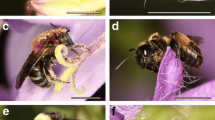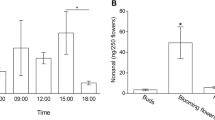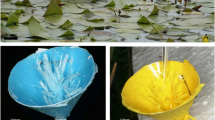Abstract
Many pollinators specialize on a few plants as food sources and rely on flower scents to recognize their hosts. However, the specific compounds mediating this recognition are mostly unknown. We investigated the chemical basis of host location/recognition in the Campanula-specialist bee Chelostoma rapunculi using chemical, electrophysiological, and behavioral approaches. Our findings show that Ca. trachelium flowers emit a weak scent consisting of both widespread and rare (i.e., spiroacetals) volatiles. In electroantennographic analyses, the antennae of bees responded to aliphatics, terpenes, aromatics, and spiroacetals; however, the bioassays revealed a more complex response picture. Spiroacetals attracted host-naive bees, whereas spiroacetals together with aliphatics and terpenes were used for host finding by host-experienced bees. On the intrafloral level, different flower parts of Ca. trachelium showed differences in the absolute and relative amounts of scent, including spiroacetals. Scent from pollen-presenting flower parts elicited more feeding responses in host-naive bees as compared to a scentless control, whereas host-experienced bees responded more to the nectar-presenting parts. Our study demonstrates the occurrence of learning (i.e., change in the bee’s innate chemical search-image) after bees gain foraging experience on host flowers. We conclude that highly specific floral volatiles play a key role in host-flower recognition by this pollen-specialist bee, and discuss our findings into the broader context of host-recognition in oligolectic bees.





Similar content being viewed by others
References
Adams RP (2007) Identification of essential oil components by gas chromatography/mass spectrometry. Allured Publishing Corporation, Carol Stream, p 804
Andrews ES, Theis N, Adler LS (2007) Pollinator and herbivore attraction to Curcubita floral volatiles. J Chem Ecol 33:1682–1691
Ayasse M, Schiestl FP, Paulus HF, Ibarra F, Francke W (2003) Pollinator attraction in a sexually deceptive orchid by means of unconventional chemicals. Proc R Soc B 270:517–522
Balao F, Herrera J, Talavera S, Dötterl S (2011) Spatial and temporal patterns of floral scent emission in Dianthus inoxianus and electroantennographic responses of its hawkmoth pollinator. Phytochemistry 72:601–609
Bergström G, Tengö J, Reith W, Francke W (1982) Multicomponent mandibular gland secretions in three species of Andrena bees (Hym., Apoidea). Z Naturforsch C 37:1124–1129
Blionis GJ, Vokou D (2001) Pollination ecology of Campanula species on Mt Olympos, Greece. Ecography 24:287–297
Burger BV (2005) Mammalian semiochemicals. Top Curr Chem 240:231–278
Burger H, Ayasse M, Häberlein CM, Schulz S, Dötterl S (2010a) Echium and Pontechium specific floral cues for host-plant recognition by the oligolectic bee Hoplitis adunca. S Afr J Bot 76:788–795
Burger H, Dötterl S, Ayasse M (2010b) Host-plant finding and recognition by visual and olfactory floral cues in an oligolectic bee. Funct Ecol 24:1234–1240
Burger H, Dötterl S, Häberlein C, Schulz S, Ayasse M (2012) An arthropod deterrent attracts specialised bees to their host plants. Oecologia 168:727–736
Cane JH, Sipes S (2006) Characterizing floral specialization by bees: analytical methods and revised lexicon for oligolecty. In: Waser NM, Ollerton J (eds) Plant-pollinator interactions: from specialization to generalization. The University of Chicago Press, Chicago, pp 99–121
Chen C, Song Q, Proffit M, Bessiíre JM, Li Z, Hossaert-Mckey M (2009) Private channel: a single unusual compound assures specific pollinator attraction in Ficus semicordata. Funct Ecol 23:941–950
Chittka L, Raine NE (2006) Recognition of flowers by pollinators. Curr Opin Plant Biol 9:428–435
Clarke KR, Gorley RN (2006) Primer v6: user manual/tutorial. Primer-E, Plymouth, p 91
Dobson HEM (1987) Role of flower and pollen aromas in host-plant recognition by solitary bees. Oecologia 72:618–623
Dobson HEM (2006) Relationship between floral frangrance composition and type of pollinator. In: Dudareva N, Pichersky E (eds) Biology of floral scent. CRC Press, Boca Raton, pp 147–198
Dobson HEM, Bergström G (2000) The ecology of pollen odors. Plant Syst Evol 222:63–87
Dötterl S, Füssel U, Jürgens A, Aas G (2005a) 1,4-Dimethoxybenzene, a floral scent compound in willows that attracts an oligolectic bee. J Chem Ecol 31:2993–2998
Dötterl S, Jürgens A (2005) Spatial fragrance patterns in flowers of Silene latifolia: Lilac compounds as olfactory nectar guides? Plant Syst Evol 255:99–109
Dötterl S, Jürgens A, Seifert K, Laube T, Weißbecker B, Schütz S (2006) Nursery pollination by a moth in Silene latifolia: the role of odours in eliciting antennal and behavioural responses. New Phytol 169:707–718
Dötterl S, Milchreit K, Schäffler I (2011) Behavioural plasticity and sex differences in host finding of a specialized bee species. J Comp Physiol A 197:1119–1126
Dötterl S, Schäffler I (2007) Flower scent of floral oil-producing Lysimachia punctata as attractant for the oil-bee Macropis fulvipes. J Chem Ecol 33:441–445
Dötterl S, Vereecken JN (2010) The chemical ecology and evolution of bee-flower interactions: a review and perspectives. Can J Zool 88:668–697
Dötterl S, Wolfe LM, Jürgens A (2005b) Qualitative and quantitative analyses of flower scent in Silene latifolia. Phytochemistry 66:203–213
Feulner M, Schuhwerk F, Dötterl S (2009) Floral scent analysis in Hieracium subgenus Pilosella and its taxonomical implications. Flora 204:495–505
Fletcher MT, Jacobs MF, Kitching W, Krohn S, Drew RAI, Haniotakis GE, Francke W (1992) Absolute stereochemistry of the 1,7-dioxaspiro[5.5]undecanols in fruit-fly species, including the olive-fly. J Chem Soc Chem Commun 19:1457–1459
Francke W, Bartels J, Meyer H, Schröder F, Kohnle U, Baader E, Vité JP (1995) Semiochemicals from bark beetles: new results, remarks, and reflections. J Chem Ecol 21:1043–1063
Francke W, Kitching W (2001) Spiroacetals in insects. Curr Org Chem 5:233–251
Francke W, Reith W, Bergström G, Tengö J (1981) Pheromone bouquet of the mandibular glands in Andrena haemorrhoa F. (Hym., Apoidea). Z Naturforsch C 36:928–932
Grison-Pigé L, Bessière J-M, Hossaert-Mckey M (2002) Specific attraction of fig-pollinating wasps: role of volatile compounds released by tropical figs. J Chem Ecol 28:283–295
Heiduk A, Brake I, Tolasch T, Frank J, Jürgens A, Meve U, Dötterl S (2010) Scent chemistry and pollinator attraction in the deceptive trap flowers of Ceropegia dolichophylla. S Afr J Bot 76:762–769
Howell AD, Alarcón R (2007) Osmia bees (Hymenoptera: Megachilidae) can detect nectar-rewarding flowers using olfactory cues. Anim Behav 74:199–205
Huber DPW, Gries R, Borden JH, Pierce HD (1999) Two pheromones of coniferophagous bark beetles found in the bark of nonhost angiosperms. J Chem Ecol 25:805–816
Jost L (1918) Die Griffelhaare der Campanulablüte. Flora 111:478–489
Kessler A, Heil M (2011) The multiple faces of indirect defences and their agents of natural selection. Funct Ecol 25:348–357
Kirchner O (1897) Blüteneinrichtungen der Campanulaceen. Jahresh Ver Vaterl Naturkd Württemb 53:193–228
Knudsen JT, Eriksson R, Gershenzon J, Stahl B (2006) Diversity and distribution of floral scent. Bot Rev 72:1–120
Kunze J, Gumbert A (2001) The combined effect of color and odor on flower choice behavior of bumblebees in flower mimic systems. Behav Ecol 12:447–456
Lunau K (1995) Notes on the colour of pollen. Plant Syst Evol 198:235–252
Lunau K, Maier EJ (1995) Innate colour preferences of flower visitors. J Comp Physiol A 177:1–19
Mcdonald JH (2009) Handbook of biological statistics. Sparky House Publishing, Baltimore, p 313
Milet-Pinheiro P, Ayasse M, Schlindwein C, Dobson HEM, Dötterl S (2012) Host location by visual and olfactory floral cues in an oligolectic bee: innate and learned behavior. Behav Ecol 23:531–538
Minckley RL, Roulston TH (2006) Incidental mutualisms and pollen specialization among bees. In: Waser NM, Ollerton J (eds) Plant-pollinator interactions: from specialization to generalization. The University of Chicago Press, Chicago, pp 69–98
Müller A, Kuhlmann M (2008) Pollen hosts of western palaearctic bees of the genus Colletes (Hymenoptera: Colletidae): the Asteraceae paradox. Biol J Linn Soc 95:719–733
Peakall R, Ebert D, Poldy J, Barrow RA, Francke W, Bower CC, Schiestl FP (2010) Pollinator specificity, floral odour chemistry and the phylogeny of Australian sexually deceptive Chiloglottis orchids: implications for pollinator-driven speciation. New Phytol 188:437–450
Pernal SF, Currie RW (2002) Discrimination and preferences for pollen-based cues by foraging honeybees, Apis mellifera L. Anim Behav 63:369–390
Praz CJ, Müller A, Dorn S (2008) Specialized bees fail to develop on non-host pollen: do plants chemically protect their pollen. Ecology 89:795–804
Raguso RA (2004) Why are some floral nectars scented? Ecology 85:1486–1494
Raguso RA (2008) Wake up and smell the roses: the ecology and evolution of floral scent. Annu Rev Ecol Evol Syst 39:549–569
Robertson C (1925) Heterotropic bees. Ecology 6:412–436
Schiestl FP, Ayasse M (2001) Post-pollination emission of a repellent compound in a sexually deceptive orchid: a new mechanism for maximizing reproductive success? Oecologia 126:531–534
Schiestl FP, Ayasse M, Paulus HF, Löfstedt C, Hansson BS, Ibarra F, Francke W (1999) Orchid pollination by sexual swindle. Nature 399:421–422
Schiestl FP, Peakall R (2005) Two orchids attract different pollinators with the same floral odour compound: ecological and evolutionary implications. Funct Ecol 19:674–680
Schlindwein C, Wittmann D, Martins CF, Hamm A, Siqueira JA, Schiffler D, Machado IC (2005) Pollination of Campanula rapunculus L. (Campanulaceae): how much pollen flows into pollination and into reproduction of oligolectic pollinators? Plant Syst Evol 250:147–156
STATSOFT, I. 2004. STATISTICA (data analysis software system). Version version 7. www.statsoft.com.
Svensson GP, Okamoto T, Kawakita A, Goto R, Kato M (2010) Chemical ecology of obligate pollination mutualisms: testing the ‘private channel’ hypothesis in the Breynia-Epicephala association. New Phytol 186:995–1004
Tengö J, Bergström G, Borgkarlson AK, Groth I, Francke W (1982) Volatile compounds from cephalic secretions of females in two cleptoparasite bee genera, Epeolus (Hym., Anthophoridae) and Coelioxys (Hym., Megachilidae). Z Naturforsch C 37:376–380
Weiss MR (1991) Floral colour changes as cues for pollinators. Nature 35:227–229
Westrich P (1989) Die Wildbienen Baden-Württembergs: Spezieller Teil: Die Gattungen und Arten. Eugen Ulmer, Stuttgart, pp 437–972
Williams NH (1983) Floral fragrances as cues in animal behavior. In: Jones EC, Little RJ (eds) Handbook of experimental pollination biology. Van Nostrand Reinhold, New York, pp 50–72
Wright GA, Schiestl FP (2009) The evolution of floral scent: the influence of olfactory learning by insect pollinators on the honest signalling of floral rewards. Funct Ecol 23:841–851
Zhang Q, Liu G, Schlyter F, Birgersson G, Anderson P, Valeur P (2001) Olfactory responses of Ips duplicatus from inner Mongolia, china to nonhost leaf and bark volatiles. J Chem Ecol 27:995–1009
Acknowledgments
We thank Hannah Burger and Irmgard Schäffler for methodological support and constructive discussions, Hans-Joachim Flügel (Lebendiges Bienenmuseum Knüllwald) and Jochen Fründ (University of Göttingen, Germany) for providing nests of Chelostoma rapunculi, Gregor Aas for use of a greenhouse in the Ecological Botanical Garden of the University of Bayreuth for flight cage experiments, and the team from the Botanical Garden of the University of Ulm for providing Campanula fields to rear Chelostoma rapunculi bees used in our experiments. We also are thankful to Heather Carew, Jana Seaman, Michael Peterson, Debrakaye Nelson, Jennifer Telfer, Jamie Williamson, and Robert Davey for conducting multiple-choice behavioral experiments, the Station Linné in Sweden for its research facilities, and Whitman College for faculty-student Research funding, including two Perry Awards. Grants were provided to PM-P (Deutscher Akademischer Austauschdienst - A/08/71732) and to CS (Conselho Nacional de Desenvolvimento Científico e Tecnológico - 305692/2009-7 and Coordenação de Aperfeiçoamento de Pessoal de Nível Superior - BEX/4236/08-4).
Author information
Authors and Affiliations
Corresponding author
Additional information
In memoriam Jan Tengö
Electronic supplementary material
Below is the link to the electronic supplementary material.
ESM 1
Electronic Supplementary Material includes details on structure elucidation and synthesis of spiroacetals and preparation of synthetic mixtures for behavioral experiments (DOC 24.3 kb)
Rights and permissions
About this article
Cite this article
Milet-Pinheiro, P., Ayasse, M., Dobson, H.E.M. et al. The Chemical Basis of Host-Plant Recognition in a Specialized Bee Pollinator. J Chem Ecol 39, 1347–1360 (2013). https://doi.org/10.1007/s10886-013-0363-3
Received:
Revised:
Accepted:
Published:
Issue Date:
DOI: https://doi.org/10.1007/s10886-013-0363-3




